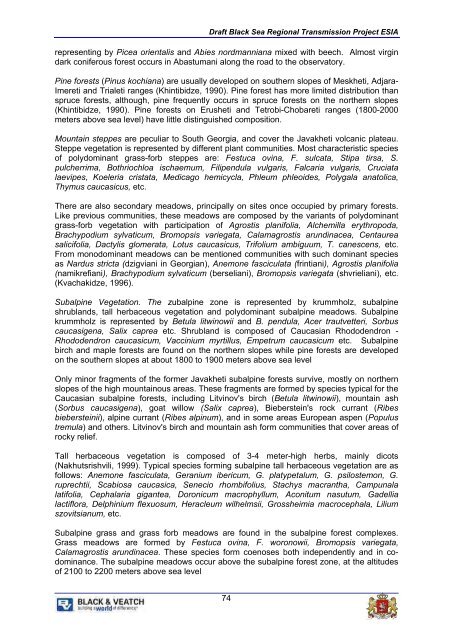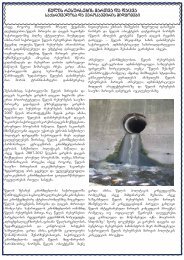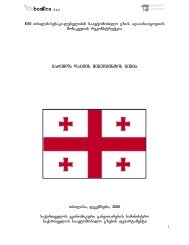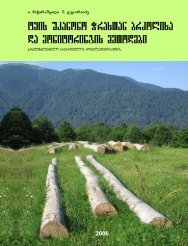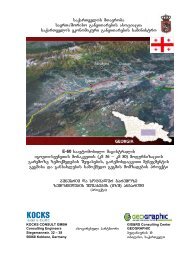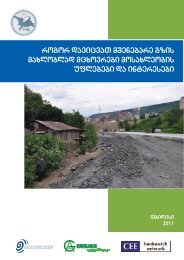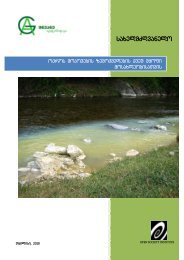Part I
Part I
Part I
You also want an ePaper? Increase the reach of your titles
YUMPU automatically turns print PDFs into web optimized ePapers that Google loves.
Draft Black Sea Regional Transmission Project ESIA<br />
representing by Picea orientalis and Abies nordmanniana mixed with beech. Almost virgin<br />
dark coniferous forest occurs in Abastumani along the road to the observatory.<br />
Pine forests (Pinus kochiana) are usually developed on southern slopes of Meskheti, Adjara-<br />
Imereti and Trialeti ranges (Khintibidze, 1990). Pine forest has more limited distribution than<br />
spruce forests, although, pine frequently occurs in spruce forests on the northern slopes<br />
(Khintibidze, 1990). Pine forests on Erusheti and Tetrobi-Chobareti ranges (1800-2000<br />
meters above sea level) have little distinguished composition.<br />
Mountain steppes are peculiar to South Georgia, and cover the Javakheti volcanic plateau.<br />
Steppe vegetation is represented by different plant communities. Most characteristic species<br />
of polydominant grass-forb steppes are: Festuca ovina, F. sulcata, Stipa tirsa, S.<br />
pulcherrima, Bothriochloa ischaemum, Filipendula vulgaris, Falcaria vulgaris, Cruciata<br />
laevipes, Koeleria cristata, Medicago hemicycla, Phleum phleoides, Polygala anatolica,<br />
Thymus caucasicus, etc.<br />
There are also secondary meadows, principally on sites once occupied by primary forests.<br />
Like previous communities, these meadows are composed by the variants of polydominant<br />
grass-forb vegetation with participation of Agrostis planifolia, Alchemilla erythropoda,<br />
Brachypodium sylvaticum, Bromopsis variegata, Calamagrostis arundinacea, Centaurea<br />
salicifolia, Dactylis glomerata, Lotus caucasicus, Trifolium ambiguum, T. canescens, etc.<br />
From monodominant meadows can be mentioned communities with such dominant species<br />
as Nardus stricta (dzigviani in Georgian), Anemone fasciculata (frintiani), Agrostis planifolia<br />
(namikrefiani), Brachypodium sylvaticum (berseliani), Bromopsis variegata (shvrieliani), etc.<br />
(Kvachakidze, 1996).<br />
Subalpine Vegetation. The zubalpine zone is represented by krummholz, subalpine<br />
shrublands, tall herbaceous vegetation and polydominant subalpine meadows. Subalpine<br />
krummholz is represented by Betula litwinowii and B. pendula, Acer trautvetteri, Sorbus<br />
caucasigena, Salix caprea etc. Shrubland is composed of Caucasian Rhododendron -<br />
Rhododendron caucasicum, Vaccinium myrtillus, Empetrum caucasicum etc. Subalpine<br />
birch and maple forests are found on the northern slopes while pine forests are developed<br />
on the southern slopes at about 1800 to 1900 meters above sea level<br />
Only minor fragments of the former Javakheti subalpine forests survive, mostly on northern<br />
slopes of the high mountainous areas. These fragments are formed by species typical for the<br />
Caucasian subalpine forests, including Litvinov's birch (Betula litwinowii), mountain ash<br />
(Sorbus caucasigena), goat willow (Salix caprea), Bieberstein's rock currant (Ribes<br />
biebersteinii), alpine currant (Ribes alpinum), and in some areas European aspen (Populus<br />
tremula) and others. Litvinov's birch and mountain ash form communities that cover areas of<br />
rocky relief.<br />
Tall herbaceous vegetation is composed of 3-4 meter-high herbs, mainly dicots<br />
(Nakhutsrishvili, 1999). Typical species forming subalpine tall herbaceous vegetation are as<br />
follows: Anemone fasciculata, Geranium ibericum, G. platypetalum, G. psilostemon, G.<br />
ruprechtii, Scabiosa caucasica, Senecio rhombifolius, Stachys macrantha, Campunala<br />
latifolia, Cephalaria gigantea, Doronicum macrophyllum, Aconitum nasutum, Gadellia<br />
lactiflora, Delphinium flexuosum, Heracleum wilhelmsii, Grossheimia macrocephala, Lilium<br />
szovitsianum, etc.<br />
Subalpine grass and grass forb meadows are found in the subalpine forest complexes.<br />
Grass meadows are formed by Festuca ovina, F. woronowii, Bromopsis variegata,<br />
Calamagrostis arundinacea. These species form coenoses both independently and in codominance.<br />
The subalpine meadows occur above the subalpine forest zone, at the altitudes<br />
of 2100 to 2200 meters above sea level<br />
74


